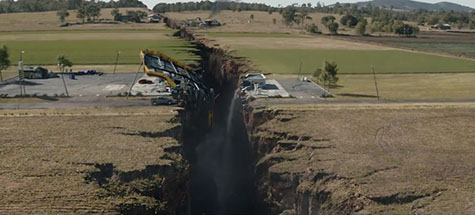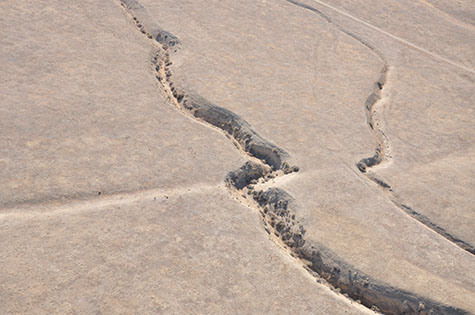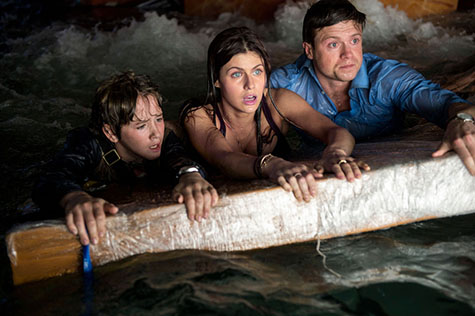
Washington University postdoc Aubreya Adams,
PhD, an earthquake seismologist who has traveled to every continent and
has installed seismometers to measure earthquakes on three of them, is
teaching a course this summer on natural disasters in film. She seemed
the ideal person to review “San Andreas,” released last Friday.
Here are her thoughts on the movie and the science (or lack thereof) behind it.
It’s a movie-star-quality fault
The San Andreas Fault of southern California is arguably the most famous fault on Earth. Its motion has caused devastating earthquakes in recent history (recent in geological terms, that is) and cuts through highly populated regions of America’s west coast, passing just east of Los Angeles. So it seems only appropriate that Hollywood’s newest disaster flick, “San Andreas,” features this, the most glamorous movie star of all geologic features.
The fault motion: WRONG
The San Andreas Fault is a strike-slip fault that separates the Pacific and the North American Plates. Motion of the two tectonic plates (which is easily monitored using GPS) is nearly parallel to the fault, and the land on either side also slides parallel to the fault. So the San Andreas Fault, where it is visible, simply looks like a line on the landscape – not the gaping chasm shown in the movie.
(Actually, even where plates are moving away from each other, deep open cracks like this do not form.)

Setting off a tsunami: WRONG
Strike-slip faults like the San Andreas do not form tsunamis. While smaller local tsunamis are sometimes formed by underwater landslides, large tsunamis are created in areas where one plate is forced down and under the other plate. This causes the whole depth of the ocean above to be pushed upward or downward, creating a massive wave that will become a tsunami. Because the San Andreas Fault is on land, and because there is little up or down motion along the fault, the San Andreas Fault cannot create a tsunami.

(Credit: New Line Cinema)
A 9.6 magnitude quake: WRONG
In “San Andreas,” the California coast is wrecked by a series of earthquakes, the largest of which was a magnitude 9.6, larger than any earthquake ever recorded. Earthquake magnitudes are related to the area of the fault that moves and how far it slips. Because of the geometry of strike-slip faults, the two sides of a fault touch over a much smaller area than in other types of faults, especially those found in subduction regions. This limits the maximum size of an earthquake that can happen on a strike-slip fault.
The largest earthquake on a strike-slip fault ever recorded was a magnitude 8.6 in the Indian Ocean, which released 1/32 of the energy a magnitude 9.6 earthquake would produce. The second largest strike-slip earthquake was actually the magnitude 8.2 aftershock of that event. Given the geometry of the San Andreas Fault and what we know about strike-slip faults, it is extremely unlikely that the San Andreas could ever produce a magnitude 9.6 earthquake.
A crescendo of earthquakes: WRONG
The major plot mechanism in “San Andreas” is a series of earthquakes, whose magnitudes increase with time, culminating in the largest magnitude 9.6 event. This increase in magnitude certainly builds drama, but is not very realistic. The vast majority of large earthquakes are followed by smaller earthquakes, called aftershocks. While these aftershocks are smaller than the mainshock, they are often large enough to cause significant damage, especially for infrastructure that has been weakened by the mainshock. And while an unlikely series of larger earthquakes may be used to build drama in a movie, in reality, a standard aftershock sequence of smaller events can create terror and havoc for the survivors of a large earthquake.
Earthquakes can be predicted: WRONG
In the movie, seismologists at CalTech discover a way to predict earthquakes based on magnetic spikes. Sadly, this is a piece of fiction. Seismologists have a pretty good idea of where earthquakes occur most frequently and the kind and size of earthquakes that are likely to occur in a region. Unfortunately, at present, we cannot predict when an earthquake will occur on the scale of days or years. We’re actually not very accurate at predicting on a decadal scale.
It’s also worth mentioning that while Earth’s magnetic field is tied to earthquakes in this and other disaster films, the magnetic field of the Earth is actually generated at a much deeper level (thousands of kilometers) by the rotation of the core and is not directly related to earthquakes (tens to hundreds of kilometers).
But there is some good news. While we can’t predict an earthquake, our ability to detect them is increasing. The first waves generated by an earthquake (called “P-waves”) are smaller and not as damaging as the types of waves that come later. Using dense networks of seismometers and sophisticated computer monitoring systems, it is now possible to send a warning signal when the early P-waves are measured, but before the largest ground waves arrive.
This gives people a few crucial seconds to seek shelter and can allow automated shutdowns of important systems that might be damaged by the more intense shaking to come. This type of technology is already in place in Japan and is currently being developed for California.
Should you go?
With all these scientific inaccuracies, you may be wondering whether you should see “San Andreas” or stay home and watch a good documentary. If you want a seismologist’s advice, I say go see it! I loved the characters and special effects; I jumped and wrung my hands in tense scenes, and even enjoyed a few laughs. But don’t be fooled into believing this excellent action movie represents realistic earthquake hazards.